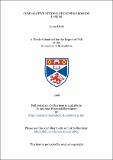Files in this item
Comparative studies of copper bromide lasers
Item metadata
| dc.contributor.advisor | Little, Christopher E. | |
| dc.contributor.author | Little, Laura | |
| dc.coverage.spatial | 230 p. | en_US |
| dc.date.accessioned | 2018-06-11T11:27:20Z | |
| dc.date.available | 2018-06-11T11:27:20Z | |
| dc.date.issued | 1998-06 | |
| dc.identifier.uri | https://hdl.handle.net/10023/13895 | |
| dc.description.abstract | This thesis reports the first comprehensive comparison of the operating regimes of the three major types of Cu halide laser, which oscillate on the 510.6 nm and 578.2 nm resonance-metastable transitions of atomic Cu in pulsed discharges at 10-50 kHz pulse recurrence frequency. The three lasers had similar active volumes (36.8-43.5 cm3) and bores (12.5-13 mm), were excited using the same power supply and circuit and monitored using the same diagnostic apparatus. The CuBr-Ne laser produced an annular output beam, weighted towards the yellow transition, with a maximum average output power of 3.55 W and a maximum efficiency of 0.71 %. When H2 gas was added to this laser at a level of ~5%, the output beam developed an axial (central) peak in intensity, the beam was less constricted, the balance of green and yellow powers was improved, the output power rose to a maximum of 11.4 W and the maximum efficiency reached 1.47 %. In both of these lasers, the CuBr vapour was generated by heating a sidearm of the discharge tube. The vapour was entrained in a flow of Ne buffer gas to seed the active volume. A Cu hybrid laser, where CuBr is generated in the tube in situ by reaction of the discharge products of a Ne-HBr buffer gas with Cu pieces in the tube, has been compared to the two conventional CuBr lasers. The Cu hybrid laser also produced an output beam with a central maximum, little or no constriction and a good balance of green and yellow powers. Maximum average output power reached 12.8 W and the maximum efficiency was 1.66%. In terms of specific average output power, the hybrid laser was clearly superior to the other two, with values of 82 mW.cm-3 (CuBr), 262 mW.cm-3 (CuBr-H2) and 348 mW.cm-3 (Cu hybrid). The specific output power of the Cu hybrid laser obtained in these studies is a record value for any Cu laser (including elemental Cu lasers) of tube bore ~12.5 mm. This result and the general dependences of output power on buffer gas pressure, additive (H2, HBr) pressure, pulse recurrence frequency and charging voltage and capacitances are discussed in detail in terms of the fundamental processes and chemical reactions. The most important processes responsible for the high powers and efficiencies and the Gaussian-like beam profiles in the presence of hydrogen are dissociative attachment of HBr in the interpulse period and at the beginning of the pulse, and the reduction of CuxBrx polymers and monomers by H2 to free Cu atoms in the active volume. This is the first time that the importance of hydrogen reduction in these lasers has been identified. Without it, the filling in of the annular output beam cannot be explained. The mechanism of Cu seeding of the hybrid laser has also been studied in detail, as it is the most obvious difference between the Cu hybrid and conventional CuBr lasers. The basic reactions of the seeding process are described, and it is found that in addition to Cu3Br3 and Cu4Br4 polymers there must be a substantial amount of CuH in the discharge to account for the large density of Cu atoms in free form and locked up in molecular forms. This is the first time that CuH has been suggested as a major Cu-bearing species. The process of Cu dendrite formation in the tube is also discussed. Finally, the properties of the hybrid laser have been considered from the point of view of scaling to very high average output powers. It has been shown that average output powers of 1 kW are possible using current technology. | en_US |
| dc.language.iso | en | en_US |
| dc.publisher | University of St Andrews | |
| dc.subject.lcc | TK7871.35L6 | |
| dc.subject.lcsh | Gas lasers | |
| dc.title | Comparative studies of copper bromide lasers | en_US |
| dc.type | Thesis | en_US |
| dc.type.qualificationlevel | Doctoral | en_US |
| dc.type.qualificationname | PhD Doctor of Philosophy | en_US |
| dc.publisher.institution | The University of St Andrews | en_US |
This item appears in the following Collection(s)
Items in the St Andrews Research Repository are protected by copyright, with all rights reserved, unless otherwise indicated.

